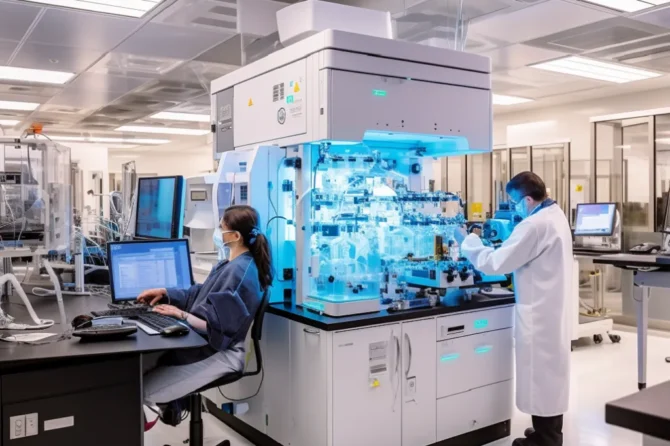Abstract:
Understanding the intricate dynamics of microbial communities within aquatic environments is pivotal to unraveling the complexities of nutrient cycling and ecosystem stability. Recent advancements in research have unveiled a fascinating link between microbial survival strategies and the expression of proteorhodopsins (PPRs), a class of light-sensitive proteins that possess the remarkable ability to harness energy from sunlight. This revelation not only expands our knowledge of microbial behavior but also sheds light on a potential lifeline that could sustain microbes in nutrient-poor environments.
Microbial communities, often hidden from the naked eye, play a vital role in shaping the health and functioning of aquatic ecosystems. These diverse microbial communities are responsible for nutrient cycling, carbon fixation, and maintaining the delicate balance of ecosystem dynamics. However, their survival in nutrient-poor conditions has long puzzled researchers. Recent studies have uncovered a pivotal role played by proteorhodopsins in this intricate puzzle, offering a glimpse into the survival mechanisms of these microbial communities.
Proteorhodopsins are integral components of microbial physiology, acting as light-driven proton pumps that generate energy through a process known as photophosphorylation. This adaptation allows certain microbes within these diverse microbial communities to harness the boundless energy of solar radiation, potentially providing them with a distinct advantage in environments where nutrients are scarce. By utilizing sunlight as an alternative energy source, the microbes equipped with proteorhodopsins can potentially circumvent the limitations imposed by nutrient availability, showcasing the adaptability of microbial communities to diverse and challenging conditions.
The relationship between proteorhodopsins and nutrient conditions is an area of intense investigation within the scientific community. Researchers are deeply engrossed in delving into the intricate mechanisms that trigger the expression of these light-sensitive proteins in response to changing nutrient availability. This nuanced expression pattern of proteorhodopsins may represent a microbial survival strategy—an innovative adaptation mechanism employed by these microorganisms to tap into an additional energy source when traditional nutrient sources are scarce or fluctuating.
This newfound understanding of the interplay between proteorhodopsins, nutrient conditions, and the behavior of microbial communities holds broader implications that extend beyond the realm of microbial survival. This discovery opens new avenues for exploring innovative approaches to sustainable ecosystem management. If we can unlock the mysteries of the complex relationship between proteorhodopsins and nutrient conditions within microbial communities, we might be empowered to manipulate these interactions in ways that enhance nutrient cycling and bolster ecosystem resilience. Such insights could pave the way for novel strategies aimed at maintaining the health and equilibrium of aquatic ecosystems, ultimately contributing to the well-being of our planet’s delicate biosphere.
The connection between microbial communities, nutrient cycling, and the role of proteorhodopsins in energy capture is a captivating story that unravels the intricacies of life within aquatic environments. This story underscores the adaptability, innovation, and resilience of microbial communities in the face of challenging conditions. As research advances and we delve deeper into the mechanisms governing these relationships, we gain valuable insights that extend far beyond the microscopic world, offering us a broader understanding of the complex and interconnected web of life on Earth.
Introduction:
Microbial communities, often operating quietly beneath the surface of aquatic ecosystems, wield an extraordinary influence on the intricate web of life within these watery realms. As unsung heroes, they orchestrate the complex dance of nutrient cycling and help maintain the delicate equilibrium that defines life beneath the waves. At the heart of these communities, a group of proteins known as proteorhodopsins (PPRs) has taken center stage in recent scientific inquiries, revealing their captivating role in capturing energy from sunlight. However, the intrigue surrounding PPRs goes beyond their energy-harnessing capabilities, as emerging studies propose a profound connection between these proteins and the mitigation of nutrient deficiencies.
Within the vibrant tapestry of aquatic ecosystems, microbial communities function as the driving force behind nutrient cycling—a process essential to sustaining life in these environments. These microscopic organisms contribute to the breakdown of organic matter, the recycling of nutrients like carbon and nitrogen, and the intricate balance that sustains the diverse array of life forms found within aquatic habitats. Despite their small size, these microbes wield an outsized influence on the health and stability of entire ecosystems.
Proteorhodopsins, a class of light-sensitive proteins, have recently emerged as compelling actors within this microbial drama. These proteins possess a unique ability to harness energy from sunlight, converting it into usable cellular energy through a process known as photophosphorylation. This adaptation enables certain microbes to tap into an alternative energy source, potentially offering them a competitive edge in environments where traditional nutrient sources are limited.
However, the story of PPRs becomes even more intriguing when considering their potential role in mitigating nutrient deficiencies. In aquatic environments where nutrients such as nitrogen, phosphorus, and iron are in short supply, the ability of microbial communities to adapt and flourish takes on paramount importance. Recent research suggests that the presence and expression of PPRs might represent a vital survival strategy for these microbes. By capturing solar energy, microbes equipped with PPRs could offset the limitations imposed by nutrient scarcity, potentially allowing them to thrive even in challenging conditions.
The relationship between expressed PPRs and nutrient conditions is an area of active investigation. Scientists are delving into the intricate mechanisms that trigger the expression of these proteins in response to changing nutrient availability. Understanding how microbes regulate PPR expression could provide valuable insights into their adaptation strategies and their potential to maintain ecosystem functionality even in nutrient-poor environments.
The Relationship Between PPRs and Nutrient Conditions in Microbial Communities:
In the intricate tapestry of microbial communities within aquatic environments, adaptability stands as a hallmark of their survival strategies. Among the many challenges these communities face, nutrient limitation emerges as a recurring obstacle, compelling them to evolve innovative mechanisms for sustenance. Enter the proteorhodopsins (PPRs), an intriguing class of proteins that introduces a fascinating new dimension to the adaptive repertoire of these microbial communities. Recent studies have shed light on the role of PPRs in environments where nutrients are scarce, revealing a nuanced interplay between these proteins and microeukaryotes—particularly phytoplankton—in their quest for survival.
Microbial communities are remarkably resilient, displaying the ability to thrive amidst changing environmental conditions. One of the most prevalent challenges they encounter is nutrient limitation, a scenario where the availability of essential nutrients, such as nitrogen, phosphorus, and iron, becomes a critical factor in determining their fate. To overcome these challenges, microorganisms have developed diverse strategies, and the emergence of PPRs introduces a novel adaptation mechanism.

Microeukaryotes, a subset of microorganisms that includes phytoplankton—a cornerstone of aquatic food webs—have been observed to respond dynamically to nutrient stress. Phytoplankton, in particular, are vital contributors to the aquatic ecosystem as primary producers, responsible for a significant portion of the planet’s oxygen production and carbon fixation. Recent investigations have revealed a captivating correlation between nutrient-stressed environments and an elevated abundance of PPRs within microeukaryotes.
What makes this discovery even more intriguing is the concept of a “dual engine” setup that microeukaryotes might adopt. In environments where nutrient resources are scarce, microeukaryotes equipped with both PPRs and the traditional photosynthetic pigment chlorophyll-a could be at an advantage. This dual setup allows them to harness energy from sunlight through PPRs while simultaneously engaging in chlorophyll-a-based photosynthesis. This supplementary energy source could potentially confer a competitive edge by bolstering essential physiological processes.
The additional energy harvested from PPRs might play a crucial role in supporting various cellular activities. Carbon dioxide assimilation, a pivotal step in the global carbon cycle, could benefit from the extra energy input. Moreover, the energy surplus might contribute to overall growth and maintenance, enabling microeukaryotes to endure the challenges posed by nutrient scarcity. This supplementary energy source could serve as a lifeline, helping these microorganisms navigate through challenging conditions and maintain their critical roles within aquatic ecosystems.
PPRs and Nutrient-Poor Environments:
The enigmatic world of nutrient-poor marine environments presents a formidable challenge for microbial communities striving to maintain their foothold in these demanding habitats. Amidst these hardships, a set of proteins known as proteorhodopsins (PPRs) emerges as pivotal players in the intricate dance of sustaining microbial life. Recent revelations shed light on the profound impact of PPRs on specific microbial groups, highlighting their significance in the adaptation strategies of organisms navigating the harsh waters of nutrient scarcity.
Among the microbial inhabitants of nutrient-poor marine ecosystems, the Flavobacteriaceae family takes on a crucial role. These microbes play an essential part in mineralizing dissolved organic carbon, a process central to nutrient cycling and maintaining the delicate balance of these ecosystems. Notably, an intriguing correlation has been observed between the expression of PPRs and the abundance of Flavobacteriaceae. This intriguing link suggests that PPRs might be intricately intertwined with the fitness and survival of these microorganisms.
Zooming in further, Candidatus Pelagibacter ubique, a prominent heterotrophic bacterium found in the ocean, adds another layer to the narrative. Heterotrophic bacteria like Candidatus Pelagibacter ubique rely on organic compounds for their energy needs. However, in nutrient-poor conditions, where organic carbon resources are limited, these bacteria face a significant challenge. Recent studies reveal that PPRs play a critical role for Candidatus Pelagibacter ubique during periods of carbon starvation. These proteins, capable of capturing energy from sunlight, potentially serve as a lifeline, offering an alternative energy source when traditional carbon sources are scarce.
The correlations between PPR expression and microbial abundance in Flavobacteriaceae and the role of PPRs in the survival of Candidatus Pelagibacter ubique collectively underscore the adaptive significance of these proteins in nutrient-poor marine environments. Such correlations indicate that PPRs could be pivotal components of the intricate adaptation mechanisms that microbial communities deploy to thrive in challenging conditions.
The implications of these findings extend beyond individual microbial groups. The resilience of microbial communities as a whole in nutrient-poor environments may be bolstered by the presence of PPRs. By providing an alternative means of energy acquisition, PPRs potentially enhance the capacity of microbial communities to weather the storm of nutrient stress. This adaptability, in turn, contributes to the overall resilience and stability of these ecosystems, as the intricate interplay between different microbial players ensures the continuation of essential nutrient cycling processes.
Differential Absorbance Spectrum Shift and Niche Differentiation:
In the vast expanse of aquatic environments, where light penetrates the depths and colors play a mesmerizing dance, an intricate relationship between proteorhodopsins (PPRs) and the spectrum of light absorbed unfolds. Recent investigations into the distribution of PPRs within the water column have illuminated a captivating phenomenon: the absorption characteristics of PPRs appear to be intimately tied to the depth distribution of microbial populations. This discovery sheds light on the remarkable adaptability of these microorganisms to their light-rich yet nutrient-poor homes.
Microbes inhabiting aquatic ecosystems exhibit an astonishing array of adaptations that allow them to thrive within their specific niches. One of these adaptations revolves around the energy-capturing prowess of PPRs, which harness light energy to drive essential cellular processes. What sets these proteins apart is their unique ability to absorb different wavelengths of light, which varies based on their composition and structural features.
Remarkably, researchers have unveiled a correlation between the spectrum of light absorbed by PPRs and the distribution of microbes within the water column. Specifically, microorganisms harboring PPRs that predominantly absorb green light tend to be more abundant in the surface waters of aquatic environments. In contrast, microbes equipped with PPRs tuned to absorb blue light dominate the deeper regions of the water column.
This spectral shift in PPR absorption aligns intriguingly with the attenuation characteristics of light as it travels through water. The deeper one delves into the aquatic realm, the more profound the impact of water’s absorption and scattering of light becomes. Blue light, with its shorter wavelength, experiences greater attenuation, making it the predominant component of the light spectrum in deeper waters. Green light, on the other hand, penetrates more effectively into the upper layers of the water column.
The correlation between PPR absorption characteristics and microbial distribution suggests an adaptive evolution strategy finely tuned to the realities of light attenuation in water. Microorganisms that inhabit surface waters, where green light prevails, are equipped with PPRs that optimally capture this abundant energy source. Similarly, microbes dwelling in the depths of the aquatic world, where blue light predominates, have evolved PPRs capable of maximizing energy capture in their specific light environment.
Such adaptations highlight the incredible versatility of microbial communities within aquatic environments. By tailoring their PPR absorption characteristics to match the light conditions of their respective niches, these microorganisms demonstrate a finely honed adaptation strategy. This strategy could play a crucial role in their energy acquisition, ultimately influencing their ability to thrive in nutrient-poor environments.
Conclusion:
The realm of microbial ecosystems within aquatic environments is a rich and intricate tapestry of interactions that shape the very fabric of nutrient cycling and ecosystem dynamics. The recent revelation of the nuanced relationship between expressed proteorhodopsins (PPRs) and nutrient conditions adds a captivating layer to our understanding of microbial survival strategies. What were once considered primarily as energy-harvesting tools have now emerged as potential game-changers in the context of nutrient-poor environments, shedding new light on the astonishing adaptability of microbial life.
Microbial communities, often unseen and yet profoundly impactful, orchestrate the delicate ballet of nutrient cycling, carbon fixation, and energy flow within aquatic ecosystems. The discovery that PPRs, initially known for their role in capturing energy from sunlight, possess a deeper connection to nutrient conditions underscores the intricate web of interactions that define microbial ecology. This newfound dimension unveils a chapter of microbial survival strategies that were once hidden beneath the surface of our comprehension.
In nutrient-poor environments, where resources are scarce and the competition for sustenance is fierce, the emergence of PPRs as potential saviors is a revelation that ignites our imagination. These proteins, by allowing certain microbes to tap into the energy of sunlight, introduce a means of energy acquisition that could potentially offset the limitations imposed by nutrient scarcity. The ingenious adaptation of microbial communities to their environment takes center stage, showcasing the remarkable capacity of life to innovate and thrive even in the most challenging circumstances.
The impact of this discovery reverberates far beyond the realm of microbial life. It speaks to the resiliency of nature’s mechanisms, demonstrating how even in seemingly inhospitable conditions, life finds a way to persist and flourish. As we gaze upon the intricate interplay between PPRs and nutrient conditions, we are reminded of the intricate balance that sustains the diversity of life within aquatic ecosystems. The ability of microbial communities to adapt, evolve, and overcome challenges exemplifies the marvel of biological diversity and the tenacity with which life clings to existence.
As the journey of scientific exploration continues, the spotlight on PPRs and their relationship with nutrient conditions provides a unique vantage point from which to observe the dynamics of microbial ecosystems. Every new revelation, every piece of insight gained through research, adds to our collective knowledge and deepens our appreciation for the intricacies of the natural world. The resilience displayed by microbial communities in the face of environmental challenges carries valuable lessons that resonate far beyond the confines of aquatic environments, reminding us of the boundless adaptability and enduring spirit of life itself.
In conclusion, the relationship between expressed PPRs and nutrient conditions within microbial ecosystems is a story that captivates and inspires. This story transcends the boundaries of microscopic life, offering insights into the very essence of adaptation, survival, and the intricate dance of life in the face of adversity. With each revelation and discovery, we peel back another layer of the mysteries that shape our world, enriching our understanding of the delicate balance that sustains ecosystems and the awe-inspiring ways in which life persists, evolves, and thrives.
If you need more information on this article click on the following link. This link will provide more extensive information and elaborate on the topic.
Genomic.News is your ultimate source for curated news, articles, and updates on the fascinating world of genomics. Our platform brings together the latest scientific breakthroughs, research advancements, and industry developments in one centralized hub. Stay informed about the cutting-edge discoveries, transformative technologies, and ethical considerations driving the field of genomics. Explore the intersection of genetics and healthcare, agriculture, biotechnology, and beyond.





